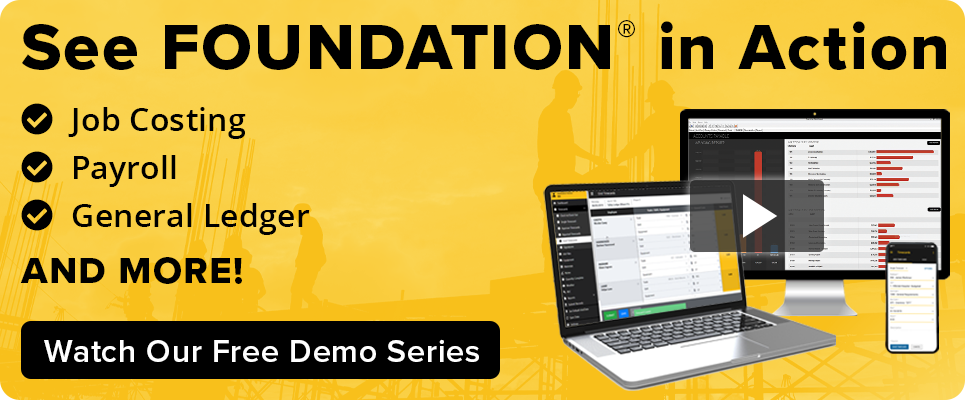
Technology Makes Simple Work of This All-Important Task
Overhead allocation is one of the most misunderstood concepts contractors face in running their business. But it is also an essential task—worthy of a great deal of attention— because it is central to determining a company’s profitability.
On the surface, overhead allocation seems simple. In addition to direct costs for materials, labor, subcontractors and equipment, companies must account for indirect costs—or overhead. Figuring out overhead costs, however, and selecting the best method for calculating these indirect costs, is not easy.

The good news is that once a method has been chosen, technology can easily allocate these costs for a complete picture of a company’s financials and job costs. Today, many construction-specific accounting systems can help contractors track overhead costs, calculate a ratio against actual expenses and report this in a way that’s understandable and accurate.
Step One: Just Do It
Without a solid understanding of overhead allocation and its importance, many contractors simply fail to allocate their indirect costs, and of those that do, most perform a partial allocation at best. In either case, contractors see only a portion of their financial picture, and usually a rosy one.
The costs most commonly allocated across jobs are associated with payroll, such as workers’ compensation insurance, state unemployment taxes, federal unemployment taxes and even liability insurance. But these payroll expenses represent only one small part of all overhead allocation costs.
To get a true account of a company’s financial health, contractors must allocate their non-job-specific overhead costs. Examples of these indirect costs include office staff salaries, rent, utilities, marketing and more. The challenge lies in how to calculate the allocation of this type of overhead.
Step Two: Select the Right Method
Generally, two methods are used to allocate overhead in construction today. Because of the many nuances and pros and cons of each, deciding which method to use can be tricky. This decision can usually be best made with help and advice from a construction CPA or accounting professional.
The first method, often referred to as the “job-cost” method, is simpler to use and understand, but often less accurate. It uses a single, pre-determined rate, multiplied by job costs to determine overhead costs. The hard part is coming up with this pre-determined rate. It involves estimating the percentage of actual costs that represent overhead (based on past actual overhead costs), to come up with a single rate that applies across all jobs.
Using this method, contractors also can estimate a flat dollar amount of overhead and add that amount to a specific cost code or type, such as material costs, unit costs and labor hours. For example, labor-intensive contractors can choose to apply a flat dollar overhead amount to labor hours, as opposed to material costs, because the hours worked on a job impact the company’s financials more than any other factor.
The second method of overhead allocation, the “general ledger” method, is more complex, yet it more accurately determines true overhead costs. Instead of using an estimated rate, this method requires tracking actual overhead costs, just as actual job costs are tracked. A percentage of those costs is then allocated to individual jobs based on each job’s percentage of total actual costs. For example, if one job’s costs represent 25 percent of the total costs on all jobs, that job receives 25 percent of the overhead expenses for the period.
The general ledger method allows for more complex formulas to accommodate “weighting” of overhead costs based on which types of costs are most relevant to the contractor. When the contractor carefully tracks and classifies both actual and overhead costs on a regular basis, this method can be accurate down to the penny.
Step Three: Simplify the Process with Technology
Contractors choosing the job-cost method of overhead allocation will find that many software programs automatically allocate costs appropriately across jobs without any additional data entry. For example, a labor-intensive subcontractor estimates that $10 per labor-hour is the overhead cost formula to be added to actual job costs. After a simple setup, this calculation is performed each and every time payroll is updated.
The overhead allocation cost, like all job costs, seamlessly integrates with payroll, accounts payable, general ledger, accounts receivable and other modules in the system.
Contractors choosing the general ledger method of overhead allocation are usually glad they spent the time determining the right formulas for their business. Depending on the sizes and types of jobs they perform, a flexible job-cost system can allocate actual overhead costs by specific costs (labor, equipment, subcontract), by all costs, by job revenue and by general ledger account.

In either method, the accounting software usually can offer both “before” and “after” reports to help a contractor see the effect that overhead has on the bottom line. In addition, the software can show the results for each job’s profitability as well as for the company as a whole. When the allocated overhead is posted back to a job, the results should appear on standard financial reports such as the income statement and statement of cash flow.
The real payoff in performing overhead allocation is not the performance itself, but the results. Contractors that perform and understand overhead costs have a more accurate understanding of all costs. It’s one important piece in the puzzle that, when put together, shows the real bottom line.
*Published in Construction Executive
Share Article
Keep on current news in the construction industry. Subscribe to free eNews!
Learn about our software more in depth with product overviews, demos, and much more!

Our ACA reporting & e-filing services include official 1094-C and 1095-C IRS reporting, optional e-filing (no applying for a TCC code required), mailing to your employees and experienced support to help you.

There are plenty of reasons to make FOUNDATION your choice for job cost accounting and construction management software — just ask our clients!

From job cost accounting software, to construction-specific payroll. Get an overview on your next all-in-one back-office solution.



